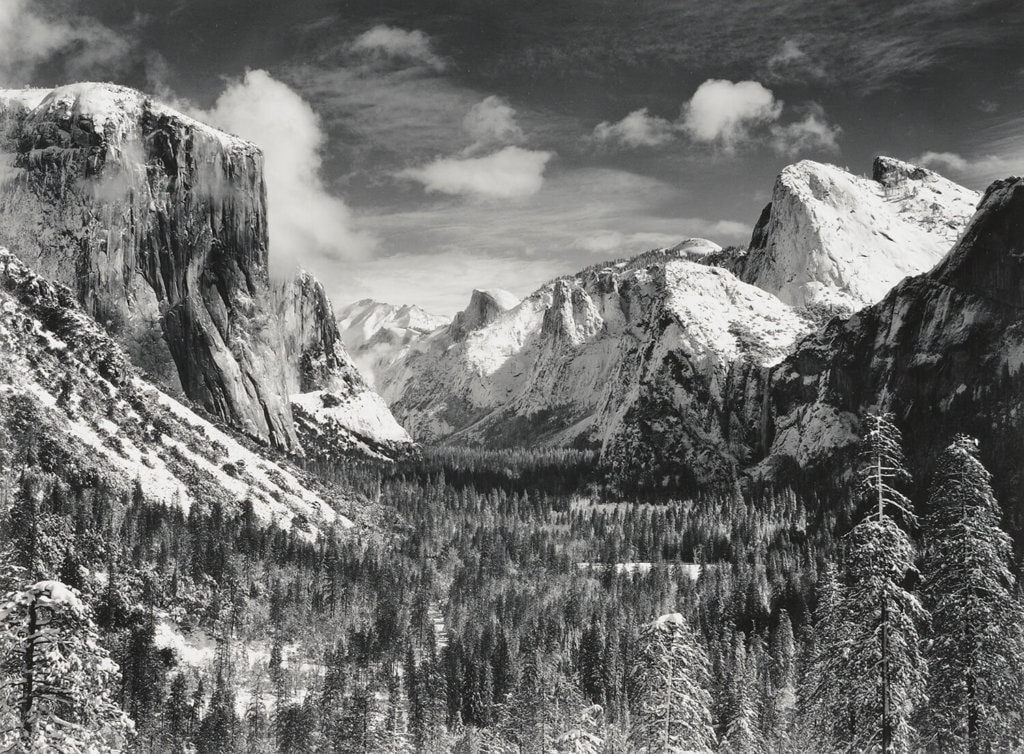
Ansel Adams Early Childhood:
Ansel Adams, born in San Francisco in 1902 before the “The Great Quake”, four years later he broke his nose in an accident and disfigured his face. Due to this as well as not fitting in at school, he struggled a lot in school land due to this moved to many school throughout his childhood until his father decided to pull him out out of education and get him a tutor. Near Ansel’s home he often walked around sand dunes and trees and found solace and a sense of support/comfort in it.
When he was younger Ansel had an interest for music as well as photography and he wanted to become a musician as he enjoyed playing on the piano, after some time he decided he wasn’t cut out for it and at age 14 he received his first ever Kodak Box Brownie Camera. At this age Ansel and his family would visit the Yosemite National Park as well as the Sierra Nevada mountainous range and from there he continued with his passion for photography.

Growing up/His background:
Ansel Adams was a well known American photographer and environmentalist. He was an advocate of environmental protection, national parks and as well as creating a legacy of responses to the power of nature and sublime conditions around. an He was known for his black and white photographs of the American West. Ansel helped found the group “Group f/64”, it was an association of photographers which advocated “pure” photography (they favoured a sharp focus and the use of the full tonal range of a photograph). Other members in this Group f/64 included Edward Weston, Imogen Cunningham (among other female photographers who had been overlooked in photography/history) and as well as Dorothea Lange.

- Imogen Cunningham and William Van Dyke
In terms of his landscape work I believe that his work is very interesting and is explainable for the amount of attention his previous work has gotten, I understand how the mountainous regions, to the lakes to the swaying grass can effect the attention and can gather there attention as his work is very mesmerising and can be adored when looked at, I believe that especially during modern day when Global Warming is a big factor in society and park preserves and landscapes don’t appear the same as many decades ago. I believe an audience can also find his work appealing as they find a sense of comfort in the fact that the range looked so calm and lively in the nature aspect despite the photographs being monochromatic.
Ansel Adams Advocate for wildlife and preservationist:
Ansel was known for his courage and constant battle with congress in order to preserve the landscapes, he dedicated his life to this nature, advocating for the protection of wilderness areas and he did not just allow “his photographs to do all the talking”. His advocacy included: essays, letters, speeches and trips to the US Congress.
In Ansel’s autobiography he wrote that “I knew my destiny when I first experienced Yosemite”. As a young boy he took his very first photographs there and continued to return to it repeatedly through his lifetime. Yosemite National Park was central to both his photography outcomes but as well as his environmental activism.
Ansel had framed his photographs to cut out any trace of human activity in the areas, bringing forth the “untouched” wilderness. As in the Yosemite which were captured in Adams’s photographs Yosemite Falls crashes down severely, a winter storm clears over Inspiration Point, and Half Dome rises like a monolith over the snow-covered Tenaya Peak.

“The final Sierra report also predicts greater snow losses during both drought years and very wet years. The findings suggest that longer, hotter dry seasons would follow the wet seasons, drying out plants that grew in those water-rich months and making record wildfires such as the state saw in 2017 more common. Extreme weather could also lead to additional challenges in flood control.”
This report can further emphasise my point where individuals can find a sort of peace in time as they can be used to such change in terms of the climate and weather overall that they feel relief and calmness.
His technique:
Ansel Adams photographed using mostly black and white film and large format cameras. He enhanced the landscapes by using yellow or orange filters in order to make the skies appear darker.
Ansel was never shy about dodging and burning to create the image he wanted despite being seen as a photographer who never manipulated his images.
The technique name he used was called “Visualisation”, it requires the photographer to take in a subject without a camera and imagining how the final photo will come out. In modern day the term “previsualisation” is used for this technique despite the concepts being the same.

In his “zone-system” technique Ansel divides the photograph into eleven zones; nine shades of gray; together with pure black and pure white. (“You could assume that a normal photo does not contain pure black and pure white. Therefore the nine shades of gray would be the only zones you can find in a photo.”)
The Zone System applies as much colour, digital and video as it does to black and white. It allows to get your the right exposure “every time without guessing”. Ansel Adams presents this in “The Negative” (his book where he cover the use of artificial and natural light, film and exposure as well as darkroom equipment and techniques) where he even shows the viewer how to use it and shoot cameras.
zone 5 being middle gray, zone 0 being pure black (with no detail), and zone 10 being pure white (with no detail)

